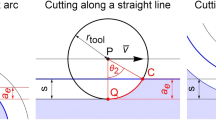An NC tool path is usually generated by sweeping parametric surfaces of a CAD model. In modern design, freeform or sculptured surfaces are increasingly popular for representing complex geometry for aesthetic or functional purposes. Traditionally, a prototype is realised by machining the workpiece using the NC codes generated from a CAD model. The machined part can then be compared with the CAD model by measurement using a coordinate measuring machine. In this paper, a reverse engineering approach to generating interference-free tool paths in three-axis machining from the scanned data from physical models is presented. There are two steps in this procedure. First, a physical model is scanned by a 3D digitiser, and multiple data sets of the complex model are obtained. A surface registration algorithm is proposed to align and integrate those data to construct a complete 3D data set. A shortest-distance method is used to determine the connecting sequence of the neighbouring points between two adjacent scan lines, such that the scanned data are converted into triangular polygons. Tool paths are then generated from the tessellated surfaces. Using the Z-map method, interference-free cutter-location data are calculated, relative to the vertex, edges, and planes of the triangles. The algorithms for tool-path generation are usually different for cutters of different geometries. Some algorithms found in the literature require complex numerical calculations and are time consuming. In this paper, an efficient algorithm is developed to calculate interference-free cutter-location data by easy geometric reasoning without complex computation. This robust method is suitable for generally used cutters such as ball, flat, and filleted end mills, and the time taken to obtain full tool paths of compound surfaces is short. Some real applications are presented to validate the proposed approach.
Similar content being viewed by others
Author information
Authors and Affiliations
Rights and permissions
About this article
Cite this article
Chuang, CM., Chen, CY. & Yau, HT. A Reverse Engineering Approach to Generating Interference-Free Tool Paths in Three-Axis Machining from Scanned Data of Physical Models. Int J Adv Manuf Technol 19, 23–31 (2002). https://doi.org/10.1007/PL00003965
Issue Date:
DOI: https://doi.org/10.1007/PL00003965




